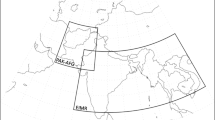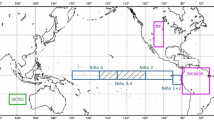Abstract
The North American Multi-Model Ensemble (NMME) provides hindcasts and real-time predictions for monthly mean climate fields at lead times of up to a year. These global climate model outputs can be useful in constructing improved seasonal forecasts. Here, several simple methods are developed and evaluated for forecasting monthly temperatures up to a year in advance based on either unweighted or weighted NMME outputs, and compared to previously developed statistical forecast methods that use only time series of past observations. It is found that the NMME-based methods produce forecast temperature probability distributions that are appropriately shifted toward the warm end of past experience and also show skill at representing interannual variability. NMME-based methods clearly outperformed purely statistical methods for forecasting temperatures over ocean, though over land this improvement is less clear over the evaluation period tested. The NMME seasonal forecasts may be particularly useful for giving early warning of heat waves, given their societal significance and higher conditional skill under those conditions.








Similar content being viewed by others
References
Aizenman H, Grossberg MD, Krakauer NY, Gladkova I (2016) Ensemble forecasts: probabilistic seasonal forecasts based on a model ensemble. Climate 4(2):19
Ariely D, Au WT, Bender RH, Budescu DV, Dietz CB, Gu H, Wallsten G, Zauberman TS (2000) The effects of averaging subjective probability estimates between and within judges. J Exp Psychol Appl 6(2):130–147
Barnston AG, Mason SJ (2011) Evaluation of IRI’s seasonal climate forecasts for the extreme 15% tails. Weather Forecast 26(4):545–554
Becker EJ, van den Dool H, Peña M (2013) Short-term climate extremes: prediction skill and predictability. J Clim 26(2):512–531
Becker E, van den Dool H, Zhang Q (2014) Predictability and forecast skill in NMME. J Clim 27(15):5891–5906
Blumenthal MB, Bell M, del Corral J, Cousin R, Khomyakov I (2014) IRI Data Library: enhancing accessibility of climate knowledge. Earth Perspect 1(1):1–12
Bradley AA, Schwartz SS (2011) Summary verification measures and their interpretation for ensemble forecasts. Mon Weather Rev 139(9):3075–3089
Casanova S, Ahrens B (2009) On the weighting of multimodel ensembles in seasonal and short-range weather forecasting. Mon Weather Rev 137:3811–3822
Claeskens G, Magnus JR, Vasnev AL, Wang W (2016) The forecast combination puzzle: a simple theoretical explanation. Int J Forecast 32(3):754–762
Coumou D, Robinson A (2013) Historic and future increase in the global land area affected by monthly heat extremes. Environ Res Lett 8(3):034018
DelSole T, Jia L, Tippett MK (2013) Scale-selective ridge regression for multimodel forecasting. J Clim 26(20):7957–7965
Donat MG, Alexander LV, Yang H, Durre I, Vose R, Dunn RJH, Willett KM, Aguilar E, Brunet M, Caesar J, Hewitson B, Jack C, Klein Tank AMG, Kruger AC, Marengo J, Peterson TC, Renom M, Oria Rojas C, Rusticucci M, Salinger J, Sanhouri Elrayah A, Sekele SS, Srivastava AK, Trewin B, Villarroel C, Vincent LA, Zhai P, Zhang X, Kitching S (2013) Updated analyses of temperature and precipitation extreme indices since the beginning of the twentieth century: The HadEX2 dataset. J Geophys Res 118(5):2098–2118
Dutton JA, James RP, Ross JD (2013) Calibration and combination of dynamical seasonal forecasts to enhance the value of predicted probabilities for managing risk. Clim Dyn 40(11–12):3089–3106 (CFSv2, ECMWF)
Eaton JW (2012) GNU Octave and reproducible research. J Process Control 22(8):1433–1438
Fischer EM, Seneviratne SI, Vidale PL, Luthi D, Schar C (2007) Soil moisture–atmosphere interactions during the 2003 European summer heat wave. J Clim 20(20):5081–5099
Fouillet A, Rey G, Laurent F, Pavillon G, Bellec S, Guihenneuc-Jouyaux C, Clavel J, Jougla E, Hémon D (2006) Excess mortality related to the August 2003 heat wave in France. Int Arch Occup Environ Health 80(1):16–24
Hawthorne S, Wang QJ, Schepen A, Robertson D (2013) Effective use of general circulation model outputs for forecasting monthly rainfalls to long lead times. Water Resourc Res 49(9):5427–5436
Hirschi M, Seneviratne SI, Alexandrov V, Boberg F, Boroneant C, Christensen OB, Formayer H, Orlowsky B, Stepanek P (2011) Observational evidence for soil-moisture impact on hot extremes in southeastern Europe. Nat Geosci 4(1):17–21
Infanti JM, Kirtman BP (2014) Southeastern U.S. rainfall prediction in the North American Multi-Model Ensemble. J Hydrometeorol 15(2):529–550
Jentsch A, Kreyling J, Elmer M, Gellesch E, Glaser B, Grant K, Hein R, Lara M, Mirzae H, Nadler SE, Nagy L, Otieno D, Pritsch K, Rascher U, Schädler M, Schloter M, Singh BK, Stadler J, Walter J, Wellstein C, Wöllecke J, Beierkuhnlein C (2011) Climate extremes initiate ecosystem-regulating functions while maintaining productivity. J Ecol 99(3):689–702
Jia XJ, Lin H (2013) The possible reasons for the misrepresented long-term climate trends in the seasonal forecasts of HFP2. Mon Weather Rev 141(9):3154–3169
Johnson C, Swinbank R (2009) Medium-range multimodel ensemble combination and calibration. Q J R Meteorol Soc 135(640A):777–794
Jordan A, Krüger F, Lerch S (2016) scoringRules: scoring rules for parametric and simulated distribution forecasts. R package version 0.9.1
Jun D, Zhou B (2011) A dynamical performance-ranking method for predicting individual ensemble member performance and its application to ensemble averaging. Mon Weather Rev 139(10):3284–3303
Kim HH, Swanson NR (2014) Forecasting financial and macroeconomic variables using data reduction methods: new empirical evidence. J Econometr 178(2):352–367
Kirtman BP, Min D, Infanti JM, Kinter JL, Paolino DA, Zhang Q, van den Dool H, Saha SMPM, Emily B, Peitao P, Patrick T, Jin H, David GD, Michael KT, Anthony GB, Shuhua L, Anthony R, Siegfried DS, Michele R, Max S, Zhao EL, Jelena M, Young-Kwon L, Joseph T, Kathleen P, William JM, Bertrand D, Eric FW (2014) The North American Multi-Model Ensemble (NMME): Phase-1 seasonal to interannual prediction, phase-2 toward developing intra-seasonal prediction. Bull Am Meteorol Soc 95:585–601
Knutti R, Furrer R, Tebaldi C, Cermak J, Meehl GA (2010) Challenges in combining projections from multiple climate models. J Clim 23(10):2739–2758
Krakauer NR (2012) Estimating climate trends: application to United States plant hardiness zones. Adv Meteorol 2012:404876
Krakauer NY, Devineni N (2015) Up-to-date probabilistic temperature climatologies. Environ Res Lett 10(2):024014
Krakauer NY, Fekete BM (2014) Are climate model simulations useful for forecasting precipitation trends? Hindcast and synthetic-data experiments. Environ Res Lett 9(2):024009
Krakauer NY, Grossberg MD, Gladkova I, Aizenman H (2013) Information content of seasonal forecasts in a changing climate. Adv Meteorol 2013:480210
Krakauer NY, Puma MJ, Cook BI (2013) Impacts of soil-aquifer heat and water fluxes on simulated global climate. Hydrol Earth Syst Sci 17(5):1963–1974
Krakauer NY (2016) SeFo: a package for generating probabilistic forecasts from NMME predictive ensembles. J Open Res Softw 4(1):e19
Krishnamurti TN, Kishtawal CM, LaRow TE, Bachiochi DR, Zhan ZC, Williford E, Gadgil S, Surendran S (1999) Improved weather and seasonal climate forecasts from multimodel superensemble. Science 285(5433):1548–1550
Ma F, Ye A, Deng X, Zhou Z, Liu X, Duan Q, Jing X, Miao C, Di Z, Gong W (2016) Evaluating the skill of NMME seasonal precipitation ensemble predictions for 17 hydroclimatic regions in continental China. Int J Climatol 36(1):132–144
Matheson JE, Winkler RL (1976) Scoring rules for continuous probability distributions. Manag Sci 22(10):1087–1096
Matthes H, Rinke A, Dethloff K (2015) Recent changes in Arctic temperature extremes: warm and cold spells during winter and summer. Environ Res Lett 10(11):114020
Mishra V, Ganguly AR, Nijssen B, Lettenmaier DP (2015) Changes in observed climate extremes in global urban areas. Environ Res Lett 10(2):024005
Moral-Benito E (2015) Model averaging in economics: an overview. J Econ Surv 29(1):46–75
Muller RA, Curry J, Groom D, Jacobsen R, Perlmutter S, Rohde R, Rosenfeld A, Wickham C, Wurtele J (2013) Decadal variations in the global atmospheric land temperatures. J Geophys Res 118D(11):5280–5286
Peng RD, Bobb JF, Tebaldi C, McDaniel L, Bell ML, Dominici F (2011) Toward a quantitative estimate of future heat wave mortality under global climate change. Environ Health Perspect 119(5):701–706
Pieroth M (2014) Non-gaussian forecast skill in ensemble prediction systems. Master’s thesis, Goethe Universität
Rahmstorf S, Coumou D (2011) Increase of extreme events in a warming world. Proc Natl Acad Sci (USA) 108(44):17905–17909
Rayner NA, Parker DE, Horton EB, Folland CK, Alexander LV, Rowell DP, Kent EC, Kaplan A (2003) Global analyses of sea surface temperature, sea ice, and night marine air temperature since the late nineteenth century. J Geophys Res 108(D14):4407
Rohde R, Muller RA, Jacobsen R, Muller E, Perlmutter S, Rosenfeld A, Wurtele J, Groom D, Wickham C (2013) A new estimate of the average Earth surface land temperature spanning 1753 to 2011. Geoinform Geostat Overv 1(1):1000101
Rohde R, Muller R, Jacobsen R, Perlmutter S, Rosenfeld A, Wurtele J, Curry J, Wickham C, Mosher S (2013) Berkeley Earth temperature averaging process. Geoinform Geostat Overv 1(2):1000103
Sherwood SC, Huber M (2010) An adaptability limit to climate change due to heat stress. Proc Natl Acad Sci (USA) 107(21):9552–9555
Slater JL, Villarini G, Bradley AA (2016) Evaluation of the skill of North-American Multi-Model Ensemble (NMME) Global Climate Models in predicting average and extreme precipitation and temperature over the continental USA. Clim Dyn:1–16. doi:10.1007/s00382-016-3286-1
Smith LA, Suckling EB, Thompson EL, Maynard T, Du H (2015) Towards improving the framework for probabilistic forecast evaluation. Clim Change 132(1):31–45
Tebaldi C, Hayhoe K, Arblaster JM, Meehl GA (2006) Going to the extremes. Clim Change 79(3–4):185–211
Tödter J (2011) New aspects of information theory in probabilistic forecast verification. Master’s thesis, Goethe University
Tingley MP, Huybers P (2013) Recent temperature extremes at high northern latitudes unprecedented in the past 600 years. Nature 496(7444):201–205
Valtorta SE (2002) Animal production in a changing climate: impacts and mitigation. In: 15th Conf. on Biometeorology/Aerobiology and 16th International Congress of Biometeorology
van der Velde M, Wriedt G, Bouraoui F (2010) Estimating irrigation use and effects on maize yield during the 2003 heatwave in France. Agric Ecosyst Environ 135:90–97
Vogel MM, Orth R, Cheruy F, Hagemann S, Lorenz R, van den Hurk BJJM, Seneviratne SI (2017) Regional amplification of projected changes in extreme temperatures strongly controlled by soil moisture-temperature feedbacks. Geophys Res Lett 44(3):1511–1519
Wanders N, Wood EF (2016) Improved sub-seasonal meteorological forecast skill using weighted multi-model ensemble simulations. Environ Res Lett 11(9):094007
Wang QJ, Schepen A, Robertson DE (2012) Merging seasonal rainfall forecasts from multiple statistical models through Bayesian model averaging. J Clim 25(12):5524–5537
Weisheimer A, Doblas-Reyes FJ, Jung T, Palmer TN (2011) On the predictability of the extreme summer 2003 over Europe. Geophys Res Lett 38:L05704
Zaitchik BF, Evans JP, Geerken RA, Smith RB (2007) Climate and vegetation in the Middle East: interannual variability and drought feedbacks. J Clim 20:3924–3941
Zaitchik BF, Macalady AK, Bonneau LR, Smith RB (2006) Europe’s 2003 heat wave: a satellite view of impacts and landatmosphere feedbacks. Int J Climatol 26(6):743–769
Zampieri M, D’Andrea F, Vautard R, Ciais P, de Noblet-Ducoudré N, Yiou P (2009) Hot European summers and the role of soil moisture in the propagation of Mediterranean drought. J Clim 22:4747–4758
Author information
Authors and Affiliations
Corresponding author
Additional information
This paper is a contribution to the special collection on the North American Multi-Model Ensemble (NMME) seasonal prediction experiment. The special collection focuses on documenting the use of the NMME system database for research ranging from predictability studies, to multi-model prediction evaluation and diagnostics, to emerging applications of climate predictability for subseasonal to seasonal predictions.This special issue is coordinated by Annarita Mariotti (NOAA), Heather Archambault (NOAA), Jin Huang (NOAA), Ben Kirtman (University of Miami) and Gabriele Villarini (University of Iowa).
Rights and permissions
About this article
Cite this article
Krakauer, N.Y. Temperature trends and prediction skill in NMME seasonal forecasts. Clim Dyn 53, 7201–7213 (2019). https://doi.org/10.1007/s00382-017-3657-2
Received:
Accepted:
Published:
Issue Date:
DOI: https://doi.org/10.1007/s00382-017-3657-2




